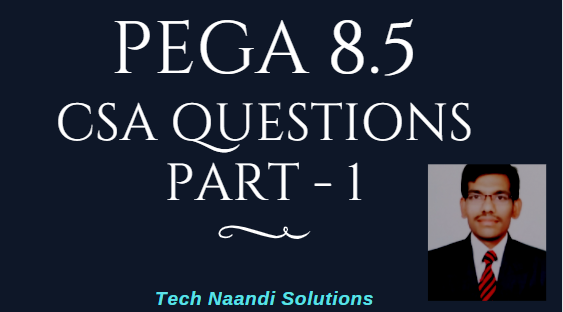Introduction (PEGA CSA Questions)
In this post, you will get all PEGA CSA Mock Test 8.5 Questions And Answers, which will help you in getting CSA certification in PEGA. with these PEGA CSA Questions.
Q1.What is a benefit of PEGA low code development?
- The PEGA low code development tools create the code for you.
- PEGA helps us to makes low code development easy for very simple applications only.
- The PEGA user interface allows only low code users to build applications.
- The PEGA low code increases both productivity and the IT environment.
4.The PEGA low code increases both productivity and the IT environment.
Q2.Case Life Cycle design is a model to __________ and ___________?
- Defines the user interface appearance.
- Defines a structure to create, process, and resolves work.
- Define how the work is completed for every specific customer request.
- Define processes and steps to implement the 3 necessary stages of work.
2.Defines a structure to create, process, and resolves work.
4.Define processes and steps to implement the 3 necessary stages of work.
Q3.Which of the following scenarios leverages case life cycle design?
- A farm creates a PEGA platform application to handle purchase requests. the first step is to get an accurate list of speed suppliers.
- An online retailer creates separate PEGA platform applications to handle purchase orders.
- A travel agency creates a PEGA platform application to handle travel booking. The business wants customers to request a reservation for a hotel room or flight, Agency employees to validate the customer-provided payment information and agents need to send booking information to the customer. The PEGA platform application has a booking case type with 3 stages as Reservation request, Validation, and confirmation.
- A customer contacts a call center to cancel service. After the Agent addresses the customer’s issues, The customer decides not to cancel the account.
3.A travel agency creates a PEGA platform application to handle travel booking. The business wants customers to request a reservation for a hotel room or flight, Agency employees to validate the customer-provided payment information and agents need to send booking information to the customer. The PEGA platform application has a booking case type with 3 stages as Reservation request, Validation, and confirmation.
Q4. Which two of the following methods can configure one stage in the case life cycle to advance to the next? (choose two options)
- When you run the case, use the actions menu to change the stage.
- You can configure the automated stage transitioning within the stage contextual property panel.
- Add a change stage Step.
- Configure the stage to resolve the case in the stage properties panel.
2.You can configure the automated stage transitioning within the stage contextual property panel.
3.Add a change stage Step.
Q5. When modeling the life cycle of a case, stages represent a ________or a________. (Choose Two)
- The subset of data used to resolve a case.
- The time period for a process to complete.
- The significant change in the status of a case.
- Transfer of authority.
2.Add a change stage Step.
4.Transfer of authority.
Q6. When modeling the life cycle of a case, alternate stages _________ and _______. (Choose two)
- Represents exceptions to the normal course of events.
- Can be sequenced into primary stages.
- Represent a separate, but a related business transaction.
- Can be reached by user action at runtime only.
1.Represents exceptions to the normal course of events.
3. Represent a separate, but related, business transaction.
Q7. Adding instructions to a step_______?
- Defines the step.
- Instructs an application developer on how to build the step.
- Describes to users the action to take in a step.
- Describes the business value of the step.
3. Describes to users the action to take in a step.
Q8. A collect Information step in the case life cycle sets the status to Pending-Approval. When does the case status automatically update?
1. Case status cannot update automatically.
2. Case status updates at the beginning of the step
3. Case status will update at the end of the available steps.
4. Case status updated at the end of the process containing the step.
2.Case status updates at the beginning of the step
Q9. What type of step typically requires contextual instructions?
1. Send an email.
2. Create a case.
3. Change stage.
4. Collect Information.
4.Collect Information.
Q10. A service level agreement describes the following behavior.
| Urgency Adjustment | Interval length |
Start of Service level | 20 |
|
Goal Interval | 10 | 8 hours |
Deadline interval | 20 | 24 Hours |
The Service level provides a four-hour initial delay. If the case urgency is set to 10 and the case reaches the assignment at 9 AM Monday. What will be the assignment urgency on Wednesday at noon?
1. 60
2. 20
3. 10
4. 50
1.60
Q11. The Gal Milestone in a service level defines that amount of time _____________?
- Allowed for users to advance to the next stage.
- Allowed before an assignment is considered overdue.
- In which the case or step should be completed.
- In which the case or step must be completed.
3. In which the case or step should be completed.
Q12. The primary purpose of a service level is to _________?
- Help ensure timely completion of work.
- Automatically change assignment status.
- Assign cases to the appropriate caseworker.
- Generate service level reports.
1.Help ensure timely completion of work.
Q13. You want users to choose their delivery preferences. The options are Standard, Premium, and Next day. You use the Data Model tab to create the field. Which field type do you use to define the delivery options list?
1. Boolean
2. User reference
3. Text(paragraph)
4. Picklist
4. Picklist
Q14. If the applicant case wants to capture the language skills of a candidate. which type of field do you configure for users to enter language skills?
1. Text (Single line or Paragraph)
2. Attachment
3. Location
1.Text (Single line or Paragraph)
Q15. To configure user views, you can add existing fields to the user view and ______________?
1. Reuse saved views.
2. Create a table with field names.
3. Add instructions to an assignment.
1.Reuse saved views.
Q16. What is the difference between field group & field group list in PEGA?
1. Afield group contains numeric values, and a field group list is a list of related items.
2. Afield group is a group of fields in a specific case type and a field group list is the list of fields in a view.
3. A field group contains a group of related properties whereas a field group list contains a list of grouped values.
4. Field group and field group lists refer to the same values.
3. A field group contains a group of related properties whereas a field group list contains a list of grouped values.
Q17. In a loan request application, candidates must enter their addresses from the past 10 years. What field type do you configure to collect this information?
1. A series of Sigle line text fields.
2. Fancy field.
3. Field Group
4. Field Group List
4. Field Group List
Q18. Which two of the following are use cases for calculated fields configured with functions? (Choose two)
1. A testing facility wants to know the average score for each test that the facility provides. You can create a test scores list and then use the calculation to generate the results by test.
2. An online ordering application calculates the cost for each item type by multiplying the quantity by the unit price.
3. A roofing supervisor monitors and tracks and the amount of time that workers spent preparing and performing jobs. As users enter a duration in each field, the Cumulative total calculates in another field. The duration fields will be in the field group list.
4. Political Campaign volunteers go door-to-door to count how many people of voting age are living in a particular neighborhood. When volunteers enter counts in one field, a cumulative total calculates in another field. The count fields are single input fields.
1. A testing facility wants to know the average score for each test that the facility provides. You can create a test scores list and then use the calculation to generate the results by test.
3. A roofing supervisor monitors and tracks and the amount of time that workers spent preparing and performing jobs. As users enter a duration in each field, the Cumulative total calculates in another field. The duration fields will be in the field group list.
Q19. Which 2 options will describe the function of a calculation network? (Choose two)
1. Determine the calculation function for a group of fields.
2. Automatically configure custom calculations.
3. Identify the relationship between fields.
4. Whenever a value changes, update all relevant fields.
2. Automatically configure custom calculations.
4. Whenever a value changes, update all relevant fields.
Q20. How is a data record different from a data type?
1. A new data record will impact the business process, whereas a new data type will impact only the system of record.
2. A change to a data record requires a new case type and a change to a data type requires a new business process.
3. A customer data record includes the customer name, email, and phone number data types.
4. A new data record did not impact the business process whereas a change to a data type generally does impact the business process.
4. A new data record did not impact the business process whereas a change to a data type generally does impact the business process.
Conclusion
These are the PEGA CSA Questions, if you want to continue with PEGA CSA Questions part -2 please click on the button below.
Thanks for your support we will provide more tricks & tips for you. If you like our tricks, share these with your friends and join my Telegram Channel , WhatsApp Channel And Youtube Channels for more new tricks & tips.
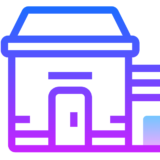
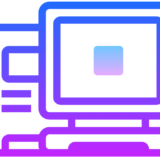
 PEGA Interview Questions
PEGA Interview Questions Pega Real Time Scenarios
Pega Real Time Scenarios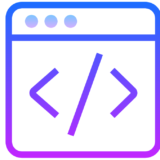

 Outlook
Outlook Android Mobile
Android Mobile Whatsapp Tricks
Whatsapp Tricks Telegram Tricks
Telegram Tricks Facebook Tricks
Facebook Tricks SMS Tricks
SMS Tricks Online Money Earnings
Online Money Earnings UAN & PF Services
UAN & PF Services Latest News / Updates
Latest News / Updates SEO Tools
SEO Tools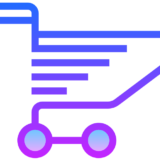

 Netflix
Netflix
